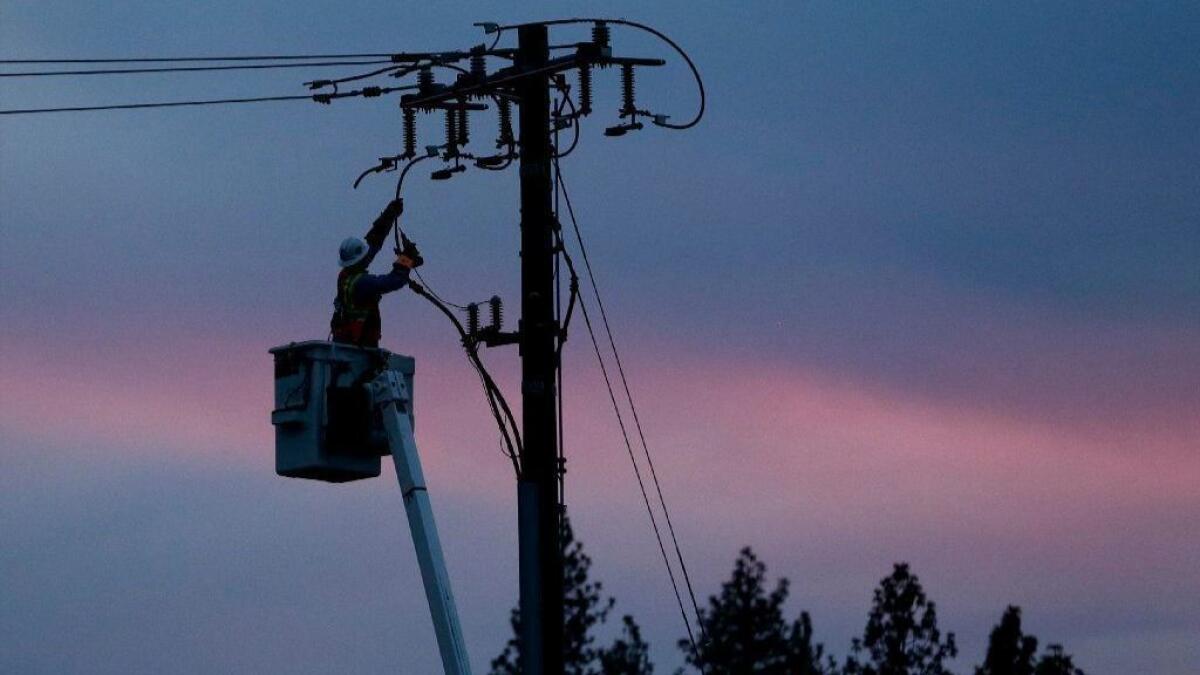PG&E should get out of the energy sales business, local governments say

- Share via
A coalition of Northern California cities and counties is calling for state officials to remove Pacific Gas & Electric from the business of buying and selling electricity, which they say would allow the troubled company to focus on the safety of its poles and wires and reduce the risk of deadly fires.
The local governments pushing that concept have already formed their own energy providers, called community choice aggregators, or CCAs. There are a dozen CCAs serving customers in PG&E’s service territory, collectively filling nearly half the electricity demand on the investor-owned utility’s power grid.
PG&E filed for bankruptcy protection last month, saying it would be unable to withstand tens of billions of dollars in potential liabilities from fires sparked by the utility’s electrical infrastructure. The company’s future is a giant question mark as state officials and a bankruptcy court judge — and another judge overseeing PG&E’s criminal probation for a deadly gas explosion — scramble to find ways to stop more fires from breaking out, while continuing to provide reliable electricity to the 5.4 million homes and businesses served by PG&E.
Now CCAs are wading into the debate.
In a filing to the California Public Utilities Commission on Wednesday, the city of San Jose and six other local energy providers said regulators should “focus the entirety of PG&E’s attention and resources on planning, operating and improving its electric transmission and distribution systems through investments that serve the mission to deliver electricity safely and reliably.” Relieving the company of its responsibility to buy and sell electricity, the CCAs wrote, would “remove any distractions as PG&E ... works to make its facilities safer.”
Officials at the San Francisco-based power company are open to the idea.
In its own filing to the Public Utilities Commission on Wednesday, PG&E said it “supports consideration” of the idea of becoming a wires-only company, which was floated by the commission as part of an investigation into PG&E’s safety culture. Implementing that plan would enable PG&E to offload power plants that carry their own risks, the company said, including the Diablo Canyon nuclear plant, which is slated to close in 2025.
“The potential benefit of a wires-only company would be that, by reducing the total number of risks managed by PG&E, it could lead to better management of the remaining risks,” the company wrote in its filing.
From a business perspective, the idea of a monopoly utility company giving up its role as a power broker isn’t as crazy as it might sound. California’s investor-owned utilities don’t actually profit from energy sales — they’re allowed to charge customers only what they paid for electricity on the market. Instead, they earn a regulated profit when they invest in infrastructure, including the poles and wires of the electric grid.
In fact, San Diego Gas & Electric — the state’s third-largest private utility, after PG&E and Southern California Edison — has been asking state lawmakers for a bill that would allow it to become a poles-and-wires company exclusively, after the city of San Diego’s announcement last year that it would seek to form a CCA.
PG&E and Edison haven’t endorsed SDG&E’s proposal.
But for PG&E especially, the company’s days as the main energy provider for Northern and Central California may soon be over. Twelve community choice agencies already serve more than 2.4 million of the 5.4 million customers in PG&E’s service territory, with more growth by the CCAs planned in 2019.
State lawmakers would probably need to pass a bill to get PG&E out of the energy sales business entirely. But the Public Utilities Commission could make it easier for local governments to form community choice agencies or join existing CCAs by slashing regulatory red tape, the coalition of Northern California CCAs said in its filing Wednesday.
The commission could also support cities that want to form municipal utilities by taking ownership of PG&E’s poles and wires, an option San Francisco officials are exploring, the CCAs said.
If PG&E were to stop buying and selling energy, a key question is who would provide electricity in cities and counties that don’t want to join a CCA or form a municipal utility. San Diego Gas & Electric has floated the idea of a centralized, statewide entity to serve customers who might otherwise fall through the cracks.
Community choice advocates generally oppose that concept. In their filing to the Public Utilities Commission on Wednesday, the seven Northern California CCAs said a “publicly owned and governed successor to PG&E” might be needed for cities and counties that don’t immediately go the CCA route, but only as a short-term solution while CCAs or city-run utilities are formed.
“My expectation would be that the vast, vast, vast majority would join an existing CCA or form their own, or join a co-op” or a municipal utility, said Nick Chaset, chief executive of East Bay Community Energy in Alameda County. “I think practically, yes, everyone or close to everyone will transition. But there needs to be a process in place to make sure that those who choose not to have the same level of service as everyone else.”
California’s biggest utilities are losing their monopolies. Is that a good thing? »
The CCAs that submitted the filing were East Bay Community Energy, Peninsula Clean Energy, Pioneer Community Energy, Silicon Valley Clean Energy, Sonoma Clean Power, Valley Clean Energy and the city of San Jose. In separate filings, Marin Clean Energy and Monterey Bay Community Power also said PG&E should become a wires-only company.
It’s unclear whether the five members of the Public Utilities Commission will support the idea of PG&E getting out of the energy sales business. Commission President Michael Picker has been a leading skeptic of community choice agencies, raising questions about what would happen if one or more of the CCAs fail.
Although PG&E is open to the idea of exiting the energy sales business, the company said in its own filing that the proposal would “pose several challenges and take considerable time to implement.” For instance, PG&E said, state officials may need to designate a “provider of last resort” to serve homes and businesses should CCAs or other energy providers fail, a key element of SDG&E’s proposal for a central statewide entity.
Most important, PG&E wrote, state regulators “would need confidence that the entity or entities assuming operations would manage risk as well or better, or overall public safety risk would not improve.”
More to Read
Inside the business of entertainment
The Wide Shot brings you news, analysis and insights on everything from streaming wars to production — and what it all means for the future.
You may occasionally receive promotional content from the Los Angeles Times.











